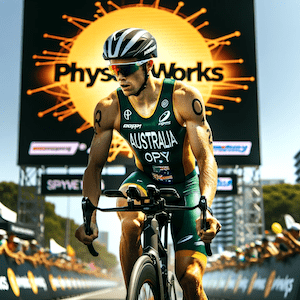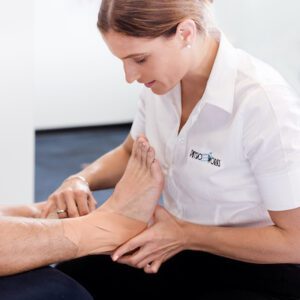Triathlon Injuries
Article by John Miller
Triathlon Injuries

Triathlon & Para Triathlon
Triathletes are vulnerable to the full spectrum of sports injuries that could be sustained from swimming, cycling or running.
Most triathletes suffer overuse or overtraining injuries, but acute traumatic injuries can also occur during an event or training.
Relative Energy Deficiency in Sport or RED-S is a known concern.
Please visit the following links dedicated to the three disciplines of a triathlon:
Most Common Triathlon Injuries
Typically, the types of injuries triathletes deal with are overuse injuries.
Triathlon training repetitively stresses muscles, tendons, and the tissues around joints and bones. This continuous stress produces repetitive microtrauma.
Overuse injuries result from the body’s inability to keep up with repair of the damage created by repetitive microtrauma. The body’s tissue eventually breaks down — resulting in pain, inflammation, and weakness.
Ignoring the pain and inflammation and continuing to train will lead to macrotrauma and disruption of the tendon, muscle or bone. The worst-case scenario is an injury that could result in weeks or months away from your triathlon training and competition.
If you need advice or you need to manage your triathlete injury, we strongly recommend that you utilise professional advice. Poorly diagnosed and mismanaged injuries can ultimately interrupt your training and event schedules.
Common Triathlon Injuries
Triathlon can lead to several common injuries, such as:
- Shin Splints: Pain along the shin bone, often caused by overuse.
- Achilles Tendinopathy: Overloading of the Achilles tendon due to excessive running.
- Swimmer’s Shoulder: Shoulder pain resulting from repetitive swimming strokes.
- Lower Back Pain: Often due to prolonged cycling or running.
- IT Band Syndrome: Pain on the outer knee, commonly from cycling or running.
- Plantar Fasciitis: Heel pain caused by inflammation of the plantar fascia.
- Stress Fracture: Bone pain due to injury load exceeding healing rate.
- RED-S: Relative Energy Deficiency in Sport. A serious multifactorial condition related to overtraining and endurance athletes.
How To Treat Triathlon Injuries
The following treatment guidelines will obviously vary depending on your specific injury.
Treatment for most triathlon injuries includes:
Acute Injury Management
- Rest, Ice, Compression, Elevation (RICE)
Soft Tissue Management
- Massage, Dry Needling, Acupuncture and Muscle Stretching
- Neural Tissue Mobility
Muscle Control
- Daily program of Core Stability Training
- Strengthening Program to Correct any Muscle Imbalances
Biomechanical Correction
- Contributing Biomechanical Factors: identification and correction
- Orthoses to correct leg length discrepancies or foot deformities
- Professional evaluation/correction of your swimming style, running gait and cycle position eg Physio or Podiatrist
- Cycling Set-up Analysis
Training Analysis
It is important to ensure that you are undertaking a well-balanced training schedule to optimise your performance and minimise your injury risk.
For more significant or persistent injuries, a triathlete should seek out quality and informed medical advice applicable to triathletes. Health professionals can include your Sports Physiotherapist, Sports Physician, Sports Podiatrist, Sports Massage Therapist, Sports Dietitian and Sports Psychologist.
Article by Zoe Russell
Sports Physiotherapy FAQs


Sports Physiotherapy is the specialised branch of physiotherapy which deals with injuries and issues related to spokespeople. Practitioners with additional formal training within Australia are Sports & Exercise Physiotherapists.
What is Sports Physiotherapy?
Sports injuries do differ from common everyday injuries. Athletes usually require high-level performance and demands placed upon their bodies, which stresses their muscles, joints and bones to the limit. Sports physiotherapists help athletes recover from sporting injuries and provide education and resources to prevent problems. Each sports physiotherapist usually has sport-specific knowledge that addresses acute, chronic and overuse injuries. Their services are generally available to sportsmen and women of all ages engaged in sports at any level of competition.
Members of Sports Physiotherapy Australia (SPA) have experience and knowledge of the latest evidence-based practice, professional assessment and diagnosis of sports injuries, and effective hands-on management techniques and exercise protocols to assist recovery and prevent future damage. SPA members have access to the most recent advances in sports physiotherapy. You'll be pleased to know that most PhysioWorks physiotherapists and massage therapists are particularly interested in sports injury management.
General Sports Physio FAQs
- Sports Physiotherapy
- Acute Sports Injury Clinics
- Sports Physiotherapy Treatment
- Youth Sports Injuries
Injury Management
- Sports Injury? What to do? When?
- When Can You Back to Sport?
- Sports-Related Injuries
- Knee Sports Injuries
- Sports Health Conditions
Sports Massage
Sports Insurance
Related Articles
- Sports Injury Management: This article provides a comprehensive look at how sports injuries are managed, including prevention strategies and treatment options.
- Soft Tissue Injury Healing: Readers can learn about the healing process for soft tissue injuries, including practical advice for each phase of recovery.
- Prehabilitation: Key to Injury-Free Sports Performance: Offers insights into how athletes can prevent injuries before they occur, focusing on strengthening and conditioning practices.
- Athletics Injuries - Comprehensive Physio Guide: A detailed guide on common injuries in athletics and how to treat and prevent them, making it a valuable resource for athletes of all levels.
- Acute Sports Injury Clinic: Highlights the services offered by sports injury clinics, including fast-track assessments and treatments for acute sports injuries.
- Effective Management of Kids Sports Injuries: This guide focuses on the unique aspects of managing sports injuries in children, offering parents and coaches valuable advice on care and prevention.




